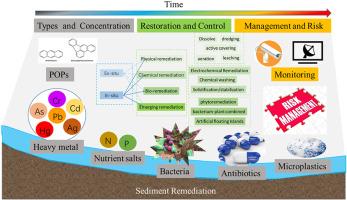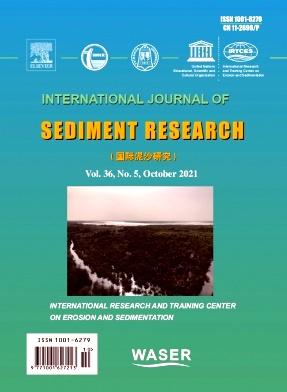Visualization analysis of global research on river and lake sediment pollution management based on CiteSpace
IF 3.7
2区 环境科学与生态学
Q2 ENVIRONMENTAL SCIENCES
引用次数: 0
Abstract
River and lake sediment is a crucial and sensitive area for the interaction between nature and human activities in the Earth's spheres. CiteSpace was applied to analyze the status quo of global river and lake sediment pollution management from 1983 to 2023. New ideas and application technologies for river and lake sediment pollution control were provided by tracking research hotspots and trends. The results indicated that the number of research papers increased rapidly approximately 2,000. Four productive teams were selected whose research focused on (1) the solidification and stabilization of contaminated sediment (team of Tsang, D.C.W., 2017–2020), (2) the adsorption and interception of persistent organic pollution (team of Cornelissen, G., 2008–2017), (3) the remediation of heavy metal pollution by novel nanomaterials (team of Zeng, G., 2016–2019), and (4) the remediation of heavy metal fields by plants (team of Tack, F.M.G., 2000–2005). In addition, interdisciplinary studies in this field are rare. Polychlorinated biphenyls, cadmium, copper, and other pollutants appeared successively, and the foregoing research tracks of pollutants reflect the development of industrial technology and changes in human lifestyles. Research on plant adsorption, microbial community degradation, and chemical fixation has exceeded the description of the physical and chemical properties of sediment pollutants. Since 2015, activated carbon, ecological risk, environmental change, and management have emerged. The current research highlights two new trends, namely, green environmental protection and environmental change, in terms of management risks in the fields of river and lake sediment pollution. This study contributes to an uplink sensing scheme for lake sediment pollution management in the future.

基于CiteSpace的全球河湖沉积物污染治理研究可视化分析
河流和湖泊沉积物是地球圈层中自然与人类活动相互作用的关键和敏感区域。应用CiteSpace软件对1983 - 2023年全球河湖沉积物污染治理现状进行了分析。通过跟踪研究热点和趋势,为河湖沉积物污染控制提供新的思路和应用技术。结果表明,研究论文数量增长迅速,约为2000篇。选择了四个高产团队,其研究重点为:(1)污染沉积物的固化与稳定(Tsang, D.C.W.团队,2017-2020),(2)持久性有机污染的吸附与拦截(Cornelissen, G.团队,2008-2017),(3)新型纳米材料对重金属污染的修复(Zeng, G.团队,2016-2019),(4)植物对重金属场的修复(Tack, F.M.G.团队,2000-2005)。此外,该领域的跨学科研究很少。多氯联苯、镉、铜等污染物相继出现,上述污染物的研究轨迹反映了工业技术的发展和人类生活方式的变化。对植物吸附、微生物群落降解和化学固定的研究已经超出了对沉积物污染物理化性质的描述。2015年以来,活性炭、生态风险、环境变化、管理等问题相继出现。当前研究在河湖底泥污染管理风险方面突出了绿色环保和环境变化两个新趋势。本研究为未来湖泊沉积物污染管理的上行传感方案提供了依据。
本文章由计算机程序翻译,如有差异,请以英文原文为准。
求助全文
约1分钟内获得全文
求助全文
来源期刊
CiteScore
6.90
自引率
5.60%
发文量
88
审稿时长
74 days
期刊介绍:
International Journal of Sediment Research, the Official Journal of The International Research and Training Center on Erosion and Sedimentation and The World Association for Sedimentation and Erosion Research, publishes scientific and technical papers on all aspects of erosion and sedimentation interpreted in its widest sense.
The subject matter is to include not only the mechanics of sediment transport and fluvial processes, but also what is related to geography, geomorphology, soil erosion, watershed management, sedimentology, environmental and ecological impacts of sedimentation, social and economical effects of sedimentation and its assessment, etc. Special attention is paid to engineering problems related to sedimentation and erosion.

 求助内容:
求助内容: 应助结果提醒方式:
应助结果提醒方式:


